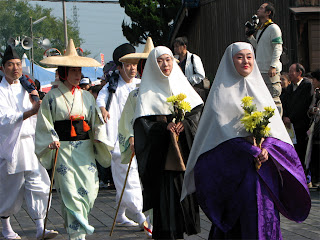The Kanzashi My Mother Wore...
This weekend we had a bit of Ulster come visit Japan - a couple who live in the very same street as we do in Magherafelt, in fact - so we did the decent thing and took them to a parade.
The Gracia Procession takes place in Nagaokakyo, south west of Kyoto, and celebrates the tragic life of Hosokawa Gracia. Tragic because her old man, a samurai, bumped off his lord and master, “Orange Oda” Nobunaga, forcing her husband to divorce the "traitor's daughter" in shame. Distraught, she turned to Christianity, and Hosokawa-san has subsequently been immortalised as Japan's first (and only) saint, a character in James Clavell's Shogun, and as a somewhat racier reincarnation in Samurai Warriors 2: Xtreme Legends.
After the decommissioning of arms that took place in 1945 under the supervision of General MacArthur, Japan has been a remarkably peaceful place (apart from the odd ‘punishment seppuku’ and ricin attack). For many centuries the two main communities – staunchly nationalist Sinn To and Johnny-come-lately spiritualists, B-UDA – have generally lived together in harmony, but a potential flashpoint has always been the tri-partite enclave surrounding Katsuryuuji Castle.
Miki O’Kamoto of the Gaasaki Road Residents’ Coalition is openly critical of the procession: “Bloody Christians, they’ve been here less than five hundred years and they march around like they own the place. Bring back Togukawa Ieyasu.”
According to the brochure they were using the 'very traditional route', but there was no mention of the location of ‘the field’.
Happily, the parade passed without incident. A spokesman for the local keisatsu-kyoku was pleased that appeals for calm and restraint had been heeded. “This is nothing though – you should see them in the summer. They go bloody bonkers with the old hanabi” he added.









